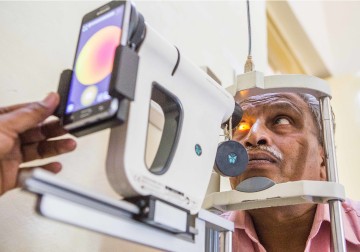In a new policy paper, Drs. Taraprasad Das, Sobha Sivaprasad, and others analyze the prevalence of type 2 diabetes and diabetic retinopathy in South Asia and review the region’s health policies. They also present a 10-point strategy for effectively managing diabetic retinopathy in South Asia.
The past two decades have seen an increasing trend of ‘lifestyle’ diseases around the world. This trend represents a change from the past when communicable diseases like cholera or malaria were the dominant causes of death and disease. Diabetes, a key lifestyle condition, is a metabolic disease that affects 537 million adults worldwide, over 90% of whom have type 2 diabetes (T2D). An estimated 3 out of 4 people with diabetes live in low- and middle-income countries. South Asia is a global diabetes hotspot, with India, Pakistan, and Bangladesh being in the top 10 nations with the highest number of people with diabetes. This disease puts millions of South Asians at risk of various diabetes-induced systemic complications.
The most common diabetic complication is diabetic retinopathy (DR). It is a blinding condition where high blood sugar damages the blood vessels in the retina, the innermost layer of the eye. DR inflicts irreparable damage to the eye and is incurable once it sets in. Hence, prevention is the key to saving the sight of patients with chronic diabetes. Wide-scale retinal screening is an effective strategy for timely detection of DR. Many high-income nations have universal and effective retinal screening protocols. But poverty, lack of health facilities, insufficient skilled workforce, and poor planning make implementing such protocols in South Asia difficult. An updated health policy is needed to obtain the latest data on diabetes and DR in the region, optimize resource allocation, and ensure that people with diabetes are screened regularly for DR.
In a new health policy paper published in The Lancet Regional Health - Southeast Asia, an international research team led by Drs. Taraprasad Das, Sobha Sivaprasad, and others analyzed the prevalence of T2D and DR in South Asia and reviewed the region’s health policies. They also presented a 10-point strategy for effectively managing DR in the region. The study notes that India has the highest prevalence of undiagnosed diabetes (53.1%) in South Asia, while Sri Lanka has the highest prevalence of diagnosed diabetes (21.8%). Afghanistan has the highest prevalence of DR (50.6%), followed by Bangladesh (36.1%) and Sri Lanka (27.4%). India has the highest absolute number of people with DR despite its prevalence being relatively low (12.5%). Worryingly, while 40.7% of Indians are aware of their diabetes, only 9.6% receive DR screening. Many Indians (65%) are unaware of DR and its sight-robbing effects.
The WHO recommends that 80% of people with diabetes be screened for DR by 2030. But meeting that goal in South Asia is difficult. Out-of-pocket spending (OOPS), medical costs borne by the patient, can go as high as 77.2% in nations like Afghanistan. Even in India, patients often bear half (50.59%) of the medical cost. South Asia is incredibly diverse and needs a customized healthcare service based on local needs. The study presents a 10-point strategy for better DR management in the region. Some of these strategies include:
- Empowering local clinics so they are better equipped at diagnosing diabetes, especially in people who are 40 years or older.
- To reduce the workload, technicians should focus on people with known diabetes, especially middle-aged or older people.
- Secondary eye care centers should be better equipped so there is less of a burden on large hospitals.
- Using AI-assisted retinal fundus imaging for better resolution and reduced risk of manual errors.
- Mandatory annual eye checkups.
‘Diabetic retinopathy cannot be addressed in isolation; it must be part of the holistic improvement in eye health delivery,’ remarks Dr. Taraprasad Das, Vice Chair Emeritus of LVPEI and the first author of this paper. ‘The 10-point strategy will likely improve the quality and spread of eye care, increase the eye health workforce, improve health finance, foster partnerships and create pathways to build national and supranational databases in south Asia.’
Citation
Das, T., Islam, K., Phuntsho, D., Narayanan, R., Rani, P.K., Takkar, B., Thapa, R., Moin, M., Piyasena, P.N., & Sivaprasad, S. (2024). Health transition and eye care policy planning for people with diabetic retinopathy in south Asia. The Lancet Regional Health - Southeast Asia, 27, 100435. https://doi.org/10.1016/j.lansea.2024.100435
Photo credit: DR screening, by Rajesh Pandey, WSD photo competition.



